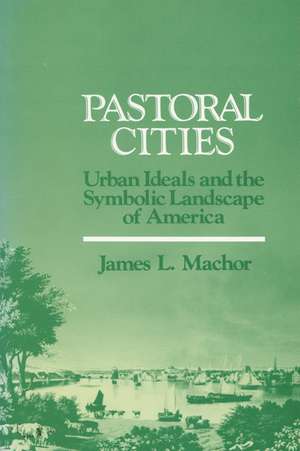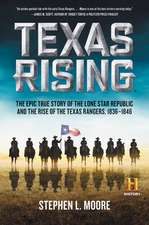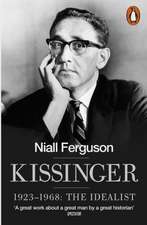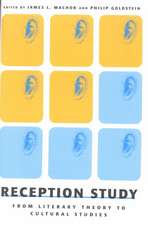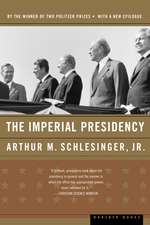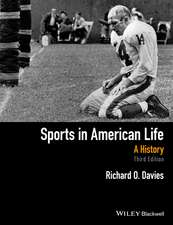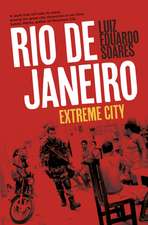Pastoral Cities: Urban Ideals: History of American Thought and Culture
Autor James L. Machoren Limba Engleză Paperback – 14 iun 1987
What has the city meant to Americans? James L. Machor explores this question in a provocative analysis of American responses to urbanization in the context of the culture’s tendency to valorize nature and the rural world.
Although much attention has been paid to American rural-urban relations, Machor focuses on a dimension largely overlooked by those seeking to explain American conceptions of the city. While urban historians and literary critics have explicitly or implicitly emphasized the opposition between urban and rural sensibilities in America, an equally important feature of American thought and writing has been the widespread interest in collapsing that division. Convinced that the native landscape has offered special opportunities, Americans since the age of settlement have sought to build a harmonious urban-pastoral society combining the best of both worlds. Moreover, this goal has gone largely unchallenged in the culture except for the sophisticated responses in the writings of some of America’s most eminent literary artists.
Pastoral Cities explains the development of urban pastoralism from its origins in the prophetic vision of the New Jerusalem, applied to America in the sixteenth and seventeenth centuries, through its secularization in the urban planning and reform of the 1800s. Machor critiques the sophisticated treatment of urban pastoralism by writers such as Emerson, Whitman, Hawthorne, Wharton, and James by skillfully by combining cultural analysis with a close reading of urban plans, travel narratives, sermons, and popular novels. The product of this multifaceted approach is an analysis that works to reveal both the strengths and weaknesses of the pastoral ideal as cultural mythology.
Although much attention has been paid to American rural-urban relations, Machor focuses on a dimension largely overlooked by those seeking to explain American conceptions of the city. While urban historians and literary critics have explicitly or implicitly emphasized the opposition between urban and rural sensibilities in America, an equally important feature of American thought and writing has been the widespread interest in collapsing that division. Convinced that the native landscape has offered special opportunities, Americans since the age of settlement have sought to build a harmonious urban-pastoral society combining the best of both worlds. Moreover, this goal has gone largely unchallenged in the culture except for the sophisticated responses in the writings of some of America’s most eminent literary artists.
Pastoral Cities explains the development of urban pastoralism from its origins in the prophetic vision of the New Jerusalem, applied to America in the sixteenth and seventeenth centuries, through its secularization in the urban planning and reform of the 1800s. Machor critiques the sophisticated treatment of urban pastoralism by writers such as Emerson, Whitman, Hawthorne, Wharton, and James by skillfully by combining cultural analysis with a close reading of urban plans, travel narratives, sermons, and popular novels. The product of this multifaceted approach is an analysis that works to reveal both the strengths and weaknesses of the pastoral ideal as cultural mythology.
Preț: 104.19 lei
Nou
Puncte Express: 156
Preț estimativ în valută:
19.94€ • 21.67$ • 16.76£
19.94€ • 21.67$ • 16.76£
Carte tipărită la comandă
Livrare economică 21 aprilie-05 mai
Preluare comenzi: 021 569.72.76
Specificații
ISBN-13: 9780299112844
ISBN-10: 0299112845
Pagini: 240
Dimensiuni: 152 x 228 x 18 mm
Greutate: 0.38 kg
Editura: University of Wisconsin Press
Colecția University of Wisconsin Press
Seria History of American Thought and Culture
ISBN-10: 0299112845
Pagini: 240
Dimensiuni: 152 x 228 x 18 mm
Greutate: 0.38 kg
Editura: University of Wisconsin Press
Colecția University of Wisconsin Press
Seria History of American Thought and Culture
Recenzii
“[Machor] traces the ideal of urban pastoralism back to the Old Testament prophets, More’s Utopia, Cortes’s description of the Aztecs, the Puritans, and various 18th-century Americans and 19th-century movements. One of the book’s most valuable chapters treats urban pastoralism in Emerson, Whitman, and Hawthorne.”—R. M. Baird, Choice
Notă biografică
James L. Machor is professor of English at Kansas State University. He is author and editor of many books, including Reception Study: From Literary Theory to Cultural Studies and Readers in History: Nineteenth-Century American Literature and the Context of Response.
Descriere
What has the city meant to Americans? James L. Machor explores this question in a provocative analysis of American responses to urbanization in the context of the culture’s tendency to valorize nature and the rural world.
Although much attention has been paid to American rural-urban relations, Machor focuses on a dimension largely overlooked by those seeking to explain American conceptions of the city. While urban historians and literary critics have explicitly or implicitly emphasized the opposition between urban and rural sensibilities in America, an equally important feature of American thought and writing has been the widespread interest in collapsing that division. Convinced that the native landscape has offered special opportunities, Americans since the age of settlement have sought to build a harmonious urban-pastoral society combining the best of both worlds. Moreover, this goal has gone largely unchallenged in the culture except for the sophisticated responses in the writings of some of America’s most eminent literary artists.
Pastoral Cities explains the development of urban pastoralism from its origins in the prophetic vision of the New Jerusalem, applied to America in the sixteenth and seventeenth centuries, through its secularization in the urban planning and reform of the 1800s. Machor critiques the sophisticated treatment of urban pastoralism by writers such as Emerson, Whitman, Hawthorne, Wharton, and James by skillfully by combining cultural analysis with a close reading of urban plans, travel narratives, sermons, and popular novels. The product of this multifaceted approach is an analysis that works to reveal both the strengths and weaknesses of the pastoral ideal as cultural mythology.
Although much attention has been paid to American rural-urban relations, Machor focuses on a dimension largely overlooked by those seeking to explain American conceptions of the city. While urban historians and literary critics have explicitly or implicitly emphasized the opposition between urban and rural sensibilities in America, an equally important feature of American thought and writing has been the widespread interest in collapsing that division. Convinced that the native landscape has offered special opportunities, Americans since the age of settlement have sought to build a harmonious urban-pastoral society combining the best of both worlds. Moreover, this goal has gone largely unchallenged in the culture except for the sophisticated responses in the writings of some of America’s most eminent literary artists.
Pastoral Cities explains the development of urban pastoralism from its origins in the prophetic vision of the New Jerusalem, applied to America in the sixteenth and seventeenth centuries, through its secularization in the urban planning and reform of the 1800s. Machor critiques the sophisticated treatment of urban pastoralism by writers such as Emerson, Whitman, Hawthorne, Wharton, and James by skillfully by combining cultural analysis with a close reading of urban plans, travel narratives, sermons, and popular novels. The product of this multifaceted approach is an analysis that works to reveal both the strengths and weaknesses of the pastoral ideal as cultural mythology.
